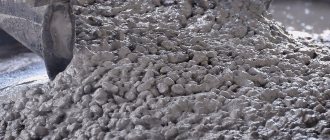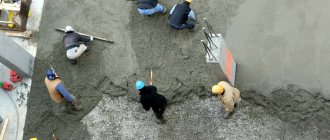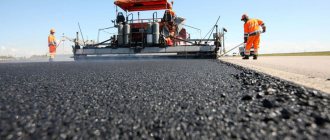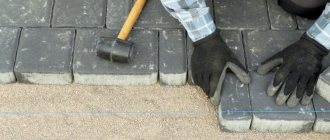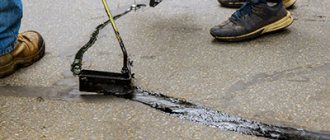Asphalt pavement, used for road construction in almost all countries of the world, can be classified into several categories. At the same time, almost all types of asphalt concrete require mandatory compaction during installation, which directly affects the quality of the road surface. However, there is a material that does not require compaction at all - cast asphalt.
“Cast asphalt is a liquid hot asphalt concrete mixture that is capable of independently gaining the required density and hardness and does not require compaction with either road rollers or manual equipment.”
Before laying, cast asphalt is heated to temperatures from 190 to 250°C, and during the cooling process, the mixture independently gains strength, turning into a hard and smooth coating. The material can be used both for the construction of highways and for paving small areas.
What are the advantages of cast asphalt?
Cast asphalt has a whole list of advantages that set it apart from many other types of asphalt concrete. At the same time, in our country the material is not the main one for road construction, as it has a high cost. However, many believe that its features compensate for the high price of the material.
Advantages of cast asphalt:
- Does not require compaction;
- High resistance to corrosion and deformation;
- Impressive strength and hardness of the material;
- Good wear resistance;
- Increased density (residual porosity only 2%);
- High moisture resistance;
- Long service life;
- The coating is smooth and even;
- Resistance to high and low temperatures;
- Resistance to temperature changes;
Moreover, all of the listed performance characteristics are not just high, but superior to those of other common types of asphalt concrete. For clarity, below is a table comparing the main characteristics of the 3 materials.
Characteristics of fine-grained asphalt concrete
Just a few decades ago, asphalt concrete mixtures containing small fractions did not tolerate temperature changes, changes in humidity and exposure to sunlight. Modern manufacturers have solved this problem by using special additives. Therefore, today this type of asphalt concrete is widely used in the construction of roads for various purposes.
One of the main advantages of this building material is that fine-grained and other types of asphalt concrete are laid without the use of expensive processes. In contrast to the asphalt concrete mixture, cutting of building materials with diamond wheels is used to construct a road surface made of reinforced concrete slabs.
Helpful advice! When ordering fine-grained asphalt concrete from production, you must request a quality certificate from the manufacturer. The document must contain the necessary characteristics for a specific batch of products.
The most durable, wear-resistant and durable are crushed stone mixtures used for the construction of airfield runways and hard surfaces of routes with heavy traffic. The strength of roads made from gravel mixtures is lower due to the fact that the smooth surface of gravel tends to reduce the adhesion forces that hold it in asphalt concrete. Less durable are mixtures made from natural sand. They are used to create pedestrian zones and cover roads with low traffic.
Relative comparison of cast, hot and cold batteries
| Material | Strength and hardness | Wear resistance | Life time | Moisture resistance | Price |
| Cast asphalt | 5 points | 5 points | 5 points | 5 points | 2 points |
| Hot AB | 5 points | 5 points | 5 points | 5 points | 5 points |
| Cold AB | 3 points | 3 points | 3 points | 3 points | 3 points |
It is worth noting that cold asphalt
is not intended for large-scale road construction, but for quick repairs or laying asphalt in small areas in cold weather.
In this case, asphalt laying is most often done with hot asphalt concrete.
, since it has high performance characteristics combined with an affordable price.
Application area
Asphalt concrete is a building material with excellent strength characteristics, so it is widely used for the construction of durable hard surfaces for roads, pedestrian areas, airport taxiways and runways. Each of the components in the mixture plays a specific role and helps to give asphalt concrete properties that allow it to be used in the construction of hard road surfaces:
- Bitumen (modified, natural). It acts as an organic binder and glues together the solid components of the asphalt concrete mixture, preventing relative movement. It is obtained by distilling petroleum products using chemical synthesis or extracted from natural deposits of bituminous rocks and asphalt.
Read on topic: Choosing a quality family car
- Small crushed stone and sand. The use of these relatively inexpensive building materials in road construction makes it possible to fill the voids formed in the body of asphalt concrete. Sand and crushed stone of different sizes effectively increases the mechanical strength, wear resistance and service life of the road surface.
- Mineral powder. It effectively reduces the fluidity and consumption of bitumen. It is obtained by breaking limestones, blast furnace slags, bituminous limestones and dolomites. Powder grinding fineness – up to 0.071 mm. Sometimes various powdered industrial wastes, for example, fly dust from cement factories, are used as mineral powders.
- Fine-grained asphalt concrete is often used for constructing sidewalks and pedestrian areas, since it costs much less than paving slabs. It is also used for minor road repairs, such as filling cracks. In military educational institutions, this type of asphalt concrete is used to create parade grounds and special areas.
Important information! Some types of asphalt concrete are laid at high temperatures. In this case, road work must be carried out taking into account safety regulations.
Road surfaces made from asphalt concrete have a long service life even when the permissible mechanical loads are exceeded. Other building materials with the same purpose do not have similar qualities.
In modern construction there are various types of building materials that are difficult to replace, since they have a strictly defined purpose. Indispensable materials include fine-grained asphalt concrete for road work, which has excellent strength characteristics. It is in demand for creating road surfaces on sites, pedestrian areas and areas adjacent to residential buildings and other buildings. Widely used for the construction of the top layer of highways when laying two-layer road surfaces.
Technology for laying cast asphalt
Despite the fact that both hot and cast asphalt can be distinguished from the varieties of asphalt concrete, cast mixtures also belong to the class of hot asphalt concrete, since they require heating and relatively warm air temperature when paving (minimum +5°C).
The technology used to lay cast asphalt is as follows:
- 1. To ensure a liquid consistency, the mixture is heated to an average of 220°C (190-250°C).
- 2. Cast asphalt is delivered to the work site using a special kocher, which is capable of maintaining the required temperature and also mixing the mixture.
- 3. Viscosity can be adjusted using polymer mineral powder, depending on the calculated load on the future web.
- 4. For laying, the mixture is filled into an asphalt paver, which will apply the AB to the base.
- 5. Depending on the required layer thickness, the paver will move at different speeds. Laying speed is from 1 to 3 meters per minute.
- 6. Then the mixture cools, during which it gains the necessary performance characteristics.
If cast asphalt is used for pothole repair, the asphalt paver can be excluded from the technological process. In this case, local filling of the cast AB is carried out directly with a Kocher.
Description:
An uneven road with many depressions causes constant negative emotions in any person, especially if you have to walk along it several times every day in one day.
Residents of areas where there is a similar problem, every now and then make requests to local authorities with requests to lay asphalt, however, they are not always in a hurry to help them. However, there is still a way out of this situation. If they wish, people can lay cold asphalt in their places of residence themselves. The video presents a detailed technology for its installation; when watching the video, it becomes clear that such manipulations are quite capable of being carried out even by those who do not have any specialized skills.
Viewers first of all see a young guy using the appropriate tools to dig in the right place. Then a shovel appears in his hands, and the young man tries to level the soil as carefully as possible, on top of which cold asphalt will subsequently be laid. Next, from the bag prepared in advance, the young man pours out the required black material, and after that it is time for a small machine, with the help of which he does the actual styling.
Soon, cars and buses calmly pass through the place, which has become perfectly flat. The sequence of actions for laying cold asphalt is absolutely not complicated or impossible; you just need to set a goal and carefully carry out all the operations prescribed by the technology. Watch the video “Cold asphalt, laying technology” in good quality 720 HD. All materials for 2022 and 2022 are contained on Youtube.com and are available on our website without registration.
Where is poured asphalt used?
The scope of application of cast asphalt is quite wide. This material can be used for paving any areas, as it has improved physical and mechanical characteristics. Its widespread use is limited only by the economic side of the issue. At the same time, in Europe, cast asphalt is used more often than in Russia, but in most cases this is due to the length of roads, which in our country are much longer than in any European country.
Chemical composition of cold asphalt
Cold asphalt is a mixture of petroleum resins, bitumen, crushed stone and plasticizers. Bitumen acts as a base; when it hardens, it binds hard stones together. Crushed stone, thanks to its sharp edges and, oddly enough, dark color, adheres noticeably better. In the case of a bitumen base, this is especially important, but more on that later. Plasticizers are necessary to create a protective film. They are the ones who do not allow the substance to harden before the adhesion process is completed. When the need for this disappears, the additives evaporate and do not interfere with further hardening.
conclusions
Cast asphalt is a liquid hot asphalt concrete mixture that does not require compaction during installation, independently gaining density and hardness as it cools. This type of asphalt has increased operational and other physical and mechanical characteristics, as well as a long service life.
Cast asphalt can be used both in private construction and in the construction of expressways and airfields. Depending on the fractions of stones in the composition of a given AB, different qualities of the material can be obtained.
Despite its high cost, cast asphalt compensates for the economic costs with its service life and rare need for repairs.
Manufacturing Features
Fine-grained asphalt mixtures are produced in specialized factories, and their laying is carried out using machinery using special methods. This building material is usually delivered to the site using special transport, since some asphalt concrete mixtures require continuous heating.
Important information! The volumetric weight of the finished fine-grained asphalt concrete depends on the proportions of the constituent elements. The building material is presented by manufacturers in several versions, which differ in the combination of the mixture or the presence of additional components.
The main task of the manufacturer is to determine the filler fraction when producing fine-grained asphalt concrete. Typically, a certain amount of crushed stone is used for this, the diameter of which does not exceed 20 mm. Correctly selected proportions make it possible to ensure the required specific gravity of the finished fine-grained asphalt concrete.
Also, the required amount of bulk substances, for example, slag or sand, is added to the asphalt concrete mixture. The thickness and ductility of the composition depends on this component. The instructions for making asphalt concrete contain the step of adding a binder. It is tar obtained as a result of oil distillation.
Read on topic: Asphalt on a concrete base
Helpful advice! Typically, manufacturers produce 2-3 types of asphalt at a specialized enterprise, which are optimally suited for specific climatic conditions. For a large order, they can make changes to the composition of the asphalt concrete mixture.
Asphalt concrete coatings - composition and technology
Asphalt concrete pavement is a compacted layer of artificial building material consisting of mineral powder, aggregates and bitumen binder. The mixture has valuable properties that are used in laying roads, constructing runways, pedestrian communications, and landscape architecture.
The history of asphalt concrete pavements goes back a long way. The American Incas built magnificent roads from stones, pouring natural bitumen into the joints. The innovation came to Europe much later. Asphalt concrete replaced stone and wooden paving stones. Today it is the most common material for road construction.
Requirements for asphalt patching repairs
Potholes and potholes are serious coating defects that significantly reduce its service life. And on the roads they create a dangerous driving environment. Therefore, it would be useful to know which documents regulate local asphalt repairs.
This information may be useful to you if you:
- Do you want to file a complaint with your local department of transportation or public amenities about poor quality work?
- You got into an accident due to poor condition of the road surface and want to hold the road services accountable
- You hired contractors to perform pothole repairs and want to evaluate the quality of their work
- Are you working on your own and want to test yourself?
In this section we will consider the following questions:
- What are the standard deadlines for repairing potholes on roads?
- How can you evaluate the quality of the repairs performed?
Let's take a closer look at each of them.
Standard terms for pothole repair
Planned routine repairs instead of major repairs are carried out in cases where the scale of damage does not exceed 12-15% of the entire road area. True, this requirement is not enshrined in regulations, but rather dictated by common sense. If the asphalt has already formed many cracks and potholes, then there is no use in patching it - it will continue to deteriorate.
Work is carried out in the following conditions:
- Spring or summer period
- Air temperature not lower than 5°C
- Lack of precipitation during asphalt laying and for several days after
But this only applies to planned repairs. It also happens that a pothole appears on the road in the fall or winter. It is impossible to leave it until good weather arrives. After all, it can lead to accidents.
In this case, GOST R 50597-2017 comes into play. It provides instructions on how to eliminate potentially dangerous coating defects.
Urgent pothole repairs should be carried out within the following time frames:
| Type of defect | Road category | Group of streets | Elimination period, no more | |
| Individual pothole, subsidence, break - more than 15 cm long - more than 5 cm deep - with an area of 0.06 m2 or more | I.A. | A (citywide streets of continuous traffic) | 1 | |
| IB, IB | B (city-wide controlled traffic streets) | 3 | ||
| II | B (district transport and pedestrian streets) | 5 | ||
| III | G (district pedestrian and transport streets and village roads) | 7 | ||
| IV | D (main streets in residential areas) | 10 | ||
| V | E (secondary streets in residential areas) | 12 | ||
| Individual pothole, subsidence, break - up to 15 cm long - up to 5 cm deep - an area of more than... | 0.1 m2 | IA, IB, IB | A, B | 5 |
| 0.5 m2 | II | IN | 7 | |
| 0.8 m2 | III | G | 10 | |
| 2.1 m2 | IV | D | 14 | |
| 5.2 m2 | V | E | 20 | |
For your convenience, we have placed this table below in the form of a picture:
You can find the full classification of city roads and streets in our article Standards for snow removal in the city.
Naturally, in conditions of urgent repairs, it is not always possible to strictly comply with the technology and GOST regulations.
The following deviations from the rules are possible:
- Filling the hole with crushed stone, broken bricks, asphalt chips and other materials
- Laying asphalt without cutting maps
- Laying cold asphalt on a wet and dirty surface
These are all temporary measures. Their goal is to quickly fix the pothole so that the road is safe to drive on. But with the onset of favorable conditions, such patches should be replaced with full ones. At a minimum, they should be made of cold asphalt laid using the correct technology, or better yet, of hot asphalt.
Now let's talk about how you can distinguish correct and technological repairs from hackwork, even if you do not have special education.
Crushed stone and sand
Either rocks or blast furnace slag from metallurgical production are used as crushed stone for the production of cast asphalt. Both materials have several strict requirements.
- The shape of the granules should be acute. The content of flat grains should not exceed 15%.
- The strength of monolithic natural granules should be 100-120 MPa, porous slag 80-100 MPa. Despite the low strength characteristics of blast furnace slag, they have good adhesion (adhesion) to the binder components of the composite due to their porous, rough surface.
Purpose and scope of application of cold asphalt concrete mixture
Most likely, it is already clear to the reader that this product is not suitable for large-scale projects, but in hard-to-reach places or in unfavorable conditions this is an ideal option. In addition to the rapid repair of small sections of roads, it is often used as a covering for manholes; due to the preservation of a certain plasticity, cracks do not form. It is also indispensable in hard-to-reach areas of overpasses or for eliminating ruts. Often, the new method is preferred by parking lot owners. They prefer to postpone the opening of parking lots to the rainy seasons in order to quickly recoup costs.
Classification of cold asphalt concrete mixtures
The main criterion is the mass fraction of crushed stone. That is, half or more are “A” class, there is no cold-resistant category in it. Less than half is “B”, 30-40% is “C”. “G” - 30%, here the second letter already appears, it denotes the very frost-resistant category. There is also a special “D” class. It does not contain large fractions as such, but has 70% sand mixed with crushing screenings. Such material can already be called fragile, and it is only suitable for private use, say in gardens.
Digital markings specific to this type of coating are “1” or “2”. The first with the addition of sand and mineral powder, the second with crushed screenings and the same mineral powder.

